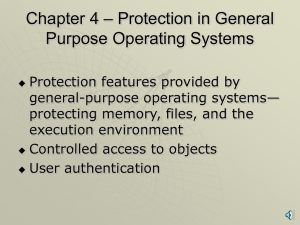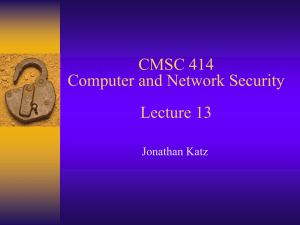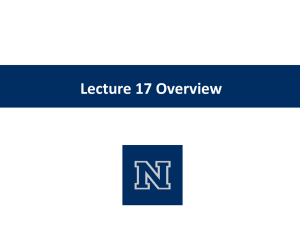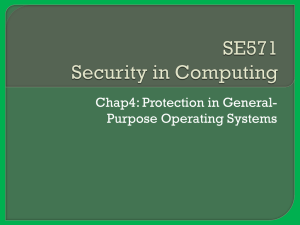CS 4803 Computer and Network Security
advertisement
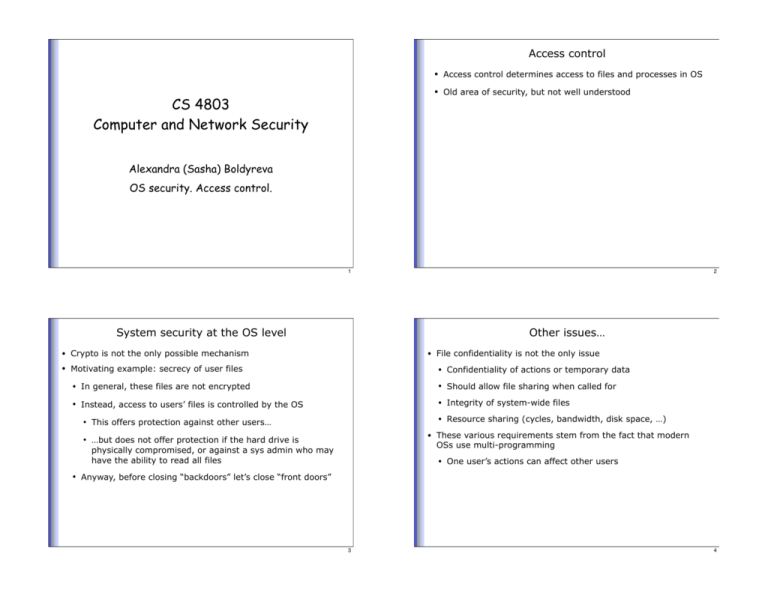
Access control CS 4803 Computer and Network Security • Access control determines access to files and processes in OS • Old area of security, but not well understood Alexandra (Sasha) Boldyreva OS security. Access control. 1 2 System security at the OS level • • Other issues… • Crypto is not the only possible mechanism File confidentiality is not the only issue Motivating example: secrecy of user files • Confidentiality of actions or temporary data • In general, these files are not encrypted • Should allow file sharing when called for • Instead, access to users’ files is controlled by the OS • Integrity of system-wide files • Resource sharing (cycles, bandwidth, disk space, …) • This offers protection against other users… • • …but does not offer protection if the hard drive is physically compromised, or against a sys admin who may have the ability to read all files These various requirements stem from the fact that modern OSs use multi-programming • One user’s actions can affect other users • Anyway, before closing “backdoors” let’s close “front doors” 3 4 Some terminology Authorization vs. authentication • • Protected entities: “objects” O, have things done to them • Active objects: “subjects” S, do things (i.e., users/processes) The issues are orthogonal • Authentication is a means of proving to the system that you are a particular user (or belong to a particular group, etc.) • Subjects/objects can be: • Authorization assumes that you have already been properly • Files authenticated, and is concerned with controlling your access to objects • Processes • Systems • We will discuss authentication later • Functions/variables (within a program) • Database entries • Etc. 5 6 Some possible approaches • Logical separation… • Physical separation • Different systems for different users • • • Complete isolation • E.g., all users/processes unaware of any others • Temporal separation “All or nothing” • Users run processes at different times • Either a file is completely public or private • Both of the above use resources poorly • Or, users either aware of each other or not • Logical separation Cryptographic separation Access control • More fine-grained; determines access at the subject/object level 7 8 Continued… • Memory protection • • Dynamic access control (capabilities) • Access may depend on the context, or on more complicated conditions • • “Fence”: restricts access to portions of memory E.g., predefined memory address where OS resides; users disallowed from modifying Limited use • Can be enforced at the hardware level • Access to object is limited: e.g., read but not modify • More difficult if OS is supposed to be “modifiable”; e.g., if systems must support multiple OSs Level of granularity is important • Finer granularity more “secure” but more difficult to implement 9 10 Continued… • Continued… • Variation is to have a “fence register” which stores the address of the protected portion of memory Fence registers have other advantages • Allow easy “relocation” by simple addition (in hardware) • Protected portion can dynamically change • Can have two such registers: base register and bounds • More opportunity for security breaches… register • Extends to allow separation of memory space for multiple users • Context switching also updates base/bounds registers 11 12 Further extensions • Tagged architecture • Note that this only protects users from each other • Does not prevent error within one user’s memory space • Base/bounds registers offer very course-grained protection • Also, have the restriction that different sections of memory space must be contiguous Can add additional base/bounds registers • • I.e., one set for instructions and one for data • In theory, can extend this; in practice it is difficult to have Possible to improve this by tagging every, e.g., word of memory via protected op. • Can be wasteful of bits… more than two sets per user • Requires changes at the hardware level 13 14 Segmentation • Program components divided into logical segments (e.g., code of a single procedure) • Each segment has a unique name; items within segment addressed by (name, offset) • Each segment stored anywhere in memory Drawbacks of segmentation? • • Users can guess memory locations • • Memory fragmentation Users can generate (name, offset) where the offset is larger than the segment size • Can imagine fixing this, but this is inefficient • OS handles mapping; transparent to user • Can implement protection for each segment Address table lookup can be slow • OS controls which programs have which entries in their segment address tables 15 16 Paging Best of both worlds? • • Similar to segmentation, but with fixed-size segments called pages • Can combine paging with segmentation • Logical units, each broken into same-size pages Addressing via (page, offset) • Avoids fragmentation problem…as well as “large offset” issue • Inefficient as program grows, since pages cannot be dynamically resized • “Re-paging” also causes potential security problems as data is shifted from one page to another • Also can be difficult to describe desired protection, since pages are no longer logical units 17 18
